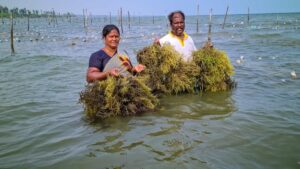GS3 – Agriculture

Context
India has identified 384 potential sites covering 24,707 hectares for seaweed cultivation, promoting marine-based livelihoods and sustainable resource utilisation.
Understanding Seaweeds
Taxonomy & Morphology:
- Seaweeds are macroscopic marine algae, found along rocky and sandy coastlines.
- Appear in red, brown, green, or black depending on pigmentation.
- Vary in size—from small mats to giant kelp reaching over 60 metres.
- Lack true roots, stems, or leaves but perform photosynthesis efficiently.
Favourable Habitat Conditions:
- Salinity: Optimal above 30 ppt.
- Temperature: Ideal range is 26°C–30°C.
- Depth: Require at least 1 metre of water at low tide.
- Substrate: Prefer rocky bottoms and clear, transparent water.
- Water Movement: Mild currents help with nutrient flow and oxygen supply.
- Growth: Some species can double their biomass in 10–15 days.
Ecological Contributions:
- Produce up to 50% of Earth’s oxygen via photosynthesis.
- Form a base for the marine food chain—supporting molluscs, fish, turtles.
- Contribute to nutrient cycling by absorbing nitrogen and phosphorus, reducing eutrophication.
Uses of Seaweed:
- Edible: Used in sushi, salads, snacks, and condiments; rich in iodine, fibre, vitamins, and antioxidants.
- Industrial: Source of binding agents in toothpaste, jelly, and cosmetics.
- Agriculture: Liquid extracts act as bio-stimulants in organic farming.
- Pharmaceuticals: Compounds with anti-inflammatory, anti-cancer, and cardio-protective benefits.
- Bioenergy: Processed for bioethanol and biogas.
Significance of Seaweed Farming:
- Livelihood Generation: Offers low-investment income avenues for marine communities.
- Climate Change Mitigation: Absorbs CO₂, reducing ocean acidification.
- Import Substitution: Despite native species, India imports carrageenan—a gel-forming compound derived from red seaweed.
- Marine Biodiversity: Seaweed beds serve as nurseries for fish and invertebrates.
- Value Addition: Supports nutraceuticals, cosmeceuticals, and bioplastics.
- Agriculture Link: Enhances soil health and productivity in organic farming.
- Geographic Leadership: Tamil Nadu leads with ~80% of India’s seaweed production (notably Gulf of Mannar).
Challenges in India:
- Seed Scarcity: Shortage of quality planting material.
- Labour Issues: Competes with seasonal agricultural work.
- Diseases: Vulnerable to epiphytes and pathogens.
- Climate Risks: Sensitive to rising sea temperatures and salinity changes.
- Regulatory Delays: Slow lease, zoning, and germplasm clearances.
- Red Tides: Harmful algal blooms threaten large-scale operations.
Government Initiatives:
- PMMSY Support: ₹195 crore allocated (2020–25).
- Seaweed Park: ₹127 crore approved for a multi-purpose park in Tamil Nadu.
- Lakshadweep Cluster: Declared a national seaweed farming cluster.
- R&D Hub: ICAR–CMFRI Mandapam designated as India’s Centre of Excellence.
- Recognised as a priority activity under Pradhan Mantri Matsya Sampada Yojana.




